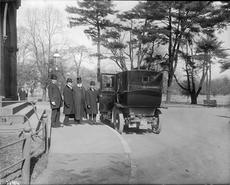The Wright Brothers: Pioneers in Aviation
 Wilbur Wright (April 16, 1867–May 30, 1912) and Orville Wright (August 19, 1871–January 30, 1948) were the inventors of the first successful airplane. They first wrote to the Smithsonian Institution in May of 1899 to request information about publications on aeronautics. At this time, they were not the "Wright Brothers" who flew the first airplane; they were simply two brothers who owned a bicycle shop in Dayton, Ohio. The brothers manufactured and sold bicycles, but Wilbur was not satisfied with this. With his brother and business partner, Orville, he began working on an early interest of theirs, flight. Before their first successful flight on December 17, 1903, at Kitty Hawk, North Carolina, the brothers spent years working on the development of the airplane.
Wilbur Wright (April 16, 1867–May 30, 1912) and Orville Wright (August 19, 1871–January 30, 1948) were the inventors of the first successful airplane. They first wrote to the Smithsonian Institution in May of 1899 to request information about publications on aeronautics. At this time, they were not the "Wright Brothers" who flew the first airplane; they were simply two brothers who owned a bicycle shop in Dayton, Ohio. The brothers manufactured and sold bicycles, but Wilbur was not satisfied with this. With his brother and business partner, Orville, he began working on an early interest of theirs, flight. Before their first successful flight on December 17, 1903, at Kitty Hawk, North Carolina, the brothers spent years working on the development of the airplane.
The brothers began by searching for information on aeronautics from their local library. Once they had gone through all of the locally available information, Wilbur Wright wrote to the Smithsonian Institution on May 30, 1899, asking for Smithsonian publications on aeronautics and suggestions for other readings. At this time, Samuel P. Langley was Secretary of the Smithsonian, and he had done extensive aeronautical research. He, too, was working on building the first flying machine. Secretary Langley was devastated when the Wright Brothers beat him with their first successful flight in 1903.
 The Wright Brothers and the Smithsonian did not always have a good relationship. After Wilbur's death in 1912, Orville became passionate about defending the Wright Brothers standing as inventors of the airplane. When Smithsonian officials displayed one of Secretary Langley's "Aerodromes," as Langley called his airplanes, with the label stating that Langley had constructed a machine "capable" of flight before the Wright Brothers successful flight, Orville was not happy. In 1925, because of this, Orville loaned the 1903 Wright Flyer to the London Science Museum, promising that it would not return to the United States until the Smithsonian renounced its claim. After almost twenty years, in 1944, Smithsonian Secretary Charles G. Abbot and Orville Wright came to terms after Abbot published a retraction. On December 17, 1948, the forty-fifth anniversary of its first flight, the 1903 Wright Flyer was placed on display in the Smithsonian's Arts and Industries Building. Today, the flyer is on display at the National Air and Space Museum.
The Wright Brothers and the Smithsonian did not always have a good relationship. After Wilbur's death in 1912, Orville became passionate about defending the Wright Brothers standing as inventors of the airplane. When Smithsonian officials displayed one of Secretary Langley's "Aerodromes," as Langley called his airplanes, with the label stating that Langley had constructed a machine "capable" of flight before the Wright Brothers successful flight, Orville was not happy. In 1925, because of this, Orville loaned the 1903 Wright Flyer to the London Science Museum, promising that it would not return to the United States until the Smithsonian renounced its claim. After almost twenty years, in 1944, Smithsonian Secretary Charles G. Abbot and Orville Wright came to terms after Abbot published a retraction. On December 17, 1948, the forty-fifth anniversary of its first flight, the 1903 Wright Flyer was placed on display in the Smithsonian's Arts and Industries Building. Today, the flyer is on display at the National Air and Space Museum.
CLASSROOM ACTIVITIES
PRIMARY SOURCES
- Letter Dated May 30, 1899
- Letter Dated June 14, 1899
- Letter Dated October 20, 1902
- Letter Dated November 7, 1902
- Letter Dated April 17, 1903
- Letter Dated June 8, 1903
FURTHER EXPLORATION
- 1903 Wright Flyer, National Air and Space Museum.
- 1909 Wright Flyer, National Air and Space Museum.
- Technical Drawings of the 1903 Wright Flyer, from the National Museum of Air and Space Archives.
- "The Great Race for a Flying Machine," Smithsonian Mobile
- Wright Brothers National Memorial located in Kill Devil Hills, North Carolina, part of the National Park Service.
- "The Wright Brothers & The Invention of the Aerial Age", National Air and Space Museum exhibit and online exhibit.
- Crouch, Tom D. The Bishop's Boys: A Life of Wilbur and Orville Wright. New York, New York: W.W. Norton, 1989.
